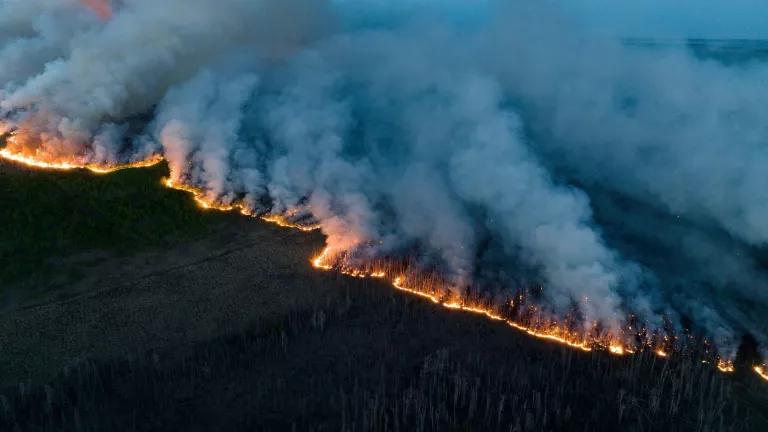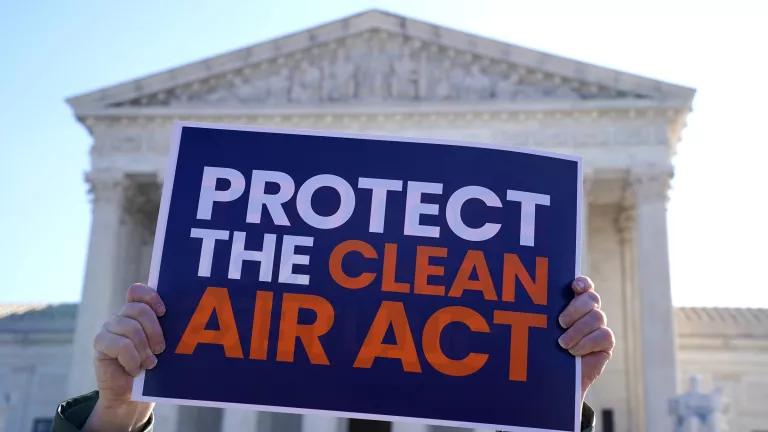EPA Must Follow Science & the Law to Cut Harmful Ozone Smog
Millions breathe unhealthy air, but EPA contends that its work is done.

Ozone smog pollution remains a threat in many parts of the country, including Las Vegas.
Even as 1 in 3 Americans breathes unhealthy levels of ozone smog, EPA contends that its work is done.
UPDATE: On December 23, 2020, the U.S. Environmental Protection Agency finalized its do-nothing rule—keeping an unsafe standard for smog and foregoing the opportunity to better protect the public, reduce asthma attacks, and save thousands of lives with a stronger standard. “We will fight this feeble, anti-science approach to dangerous air pollution with all tools available. And we’ll urge the Biden team to deliver cleaner, healthier air for all,” says Vijay Limaye.
This year marks 50 years since the Clean Air Act, a major achievement for public health, was signed into law. That law has delivered enormous public health benefits, and could do even more to protect the 120 million people around the country who still breathe unsafe air. But instead, anti-science, pro-polluter interests operating at the highest levels of the Environmental Protection Agency are taking us backward. The latest example of this reckless agenda is EPA’s proposal to let unhealthy levels of ozone air pollution linger from coast to coast. The Agency closed a short public comment period October 1.
In July, EPA Administrator Andrew Wheeler announced his decision to hit pause on the Clean Air Act’s limits on ozone smog air pollution. That decision followed a similar proposal to do nothing to strengthen standards on fine particulate matter (soot) pollution. In doing so, Wheeler seeks to allow dangerous levels of air pollution to linger around the country—even as a dangerous virus that attacks the lungs continues to challenge our country and harm our most vulnerable neighbors.
Wheeler put EPA’s smog proposal on a fast-track, with only 45 days allowed for public input. That’s why NRDC is leading a group of coalition partners to push back hard on this dangerous proposal by submitting over 100 pages of extensive comments supported by numerous scientific studies showing that EPA’s proposal is out of step with the law and the science and must be withdrawn.
Health Dangers and Costs of Ozone Smog
Ozone smog air pollution is a public health menace. It’s not spewed directly from a tailpipe or a smokestack, but rather forms in the atmosphere through the mixing of other air pollutant “building blocks.” Those building blocks include nitrogen oxides, which are produced when cars, power plants, and other industrial sources burn fossil fuels. Other sources, like wildfire smoke, also contribute to ozone pollution. The science is clear that the chemical recipe that triggers the formation ozone pollution speeds up in warmer conditions, which is why we typically see dangerous spikes in ozone air pollution (and ozone alert days) in the summertime.
Years of public health evidence show that breathing in ozone is damaging to our bodies. Short-term exposure to ozone is linked to many health problems including heart disease, reduced lung function, lung inflammation and susceptibility to infection, asthma exacerbation, and premature death from heart and lung diseases. It’s even been shown to worsen metabolic diseases like diabetes.
Ozone is dangerous to all, but particularly harmful to vulnerable groups like children, older people, those with asthma and other pre-existing lung and heart conditions, and outdoor workers. Moreover, communities of color and low income communities are disproportionately burdened by higher ambient pollution levels. Importantly, these health risks have been confirmed at levels well below the current Clean Air Act’s standard—which is why EPA should strengthen the national limits to no higher than 60 parts per billion. There are currently no national long-term limits on ozone, even though scientific evidence continues to show health problems caused from years-long exposure to this type of pollution.
In addition to the human suffering linked to ozone air pollution, it’s also an expensive health problem For example, NRDC’s analysis of ozone-related health problems in Nevada during just one year estimated nearly $900 million in health-related costs related to 97 deaths, 114 hospitalizations, and 194 trips to the emergency room from ozone exposure.
Worrying Trends
Unfortunately, our national ozone problem is poised to go from bad to worse. EPA estimates that right now, huge swaths of the country suffer from ozone levels that exceed legal limits—more than 120 million (1 in 3) Americans, by its estimate, breathe unhealthy air. With the climate crisis triggering searing, historic heat waves in recent years, ozone levels remain stubbornly high in some areas after years of decline. The American Lung Association’s annual analysis of air quality data shows that climate change is already contributing to ozone problems in places like California. Unfortunately, unprecedented wildfires, also worsened by climate change, are also driving increases in ozone and fine particle air pollution across the American West, as toxic smoke spreads hundreds of miles downwind from the flames.
NRDC Responds to EPA’s Reckless, Do-Nothing Proposal
Because EPA continues to defy the law and deny the science about ozone and public health through its recent proposal, NRDC and our coalition partners are pushing back hard. Working together, we’re today submitting extensive written comments challenging EPA’s do-nothing proposal. Specifically, we highlight:
- EPA’s failure to protect human health with an adequate margin of safety, as is required by the Clean Air Act
- EPA’s rushed, flawed, and biased science review process that ignores the impacts of ozone on vulnerable populations and harms from long-term exposures
- EPA’s distortion and manipulation of the scientific evidence base on ozone and human health, and data that demonstrate significant harms to Americans at currently permissible levels
In these comments, we point to the Clean Air Act’s requirement that EPA rely on the best available science to set strong national limits on ozone pollution that will meaningfully improve public health and protect our most vulnerable citizens. In these comments, we also demand that EPA conduct the required analysis to assess the burden of ozone on vulnerable groups and begin the work to establish a new long-term ozone limit. Simply put, EPA must follow the law and the science instead of the toxic agenda of polluting industry. In addition to our coalition group comments, members of NRDC’s Activist Network have also raised their voices in opposition to EPA’s reckless plan by submitting more than 29,000 comments directly to EPA.
The already severe health problems and healthcare costs caused by ozone air pollution are poised to grow in years to come, unless EPA reverses course on this reckless proposal. National limits on dangerous ozone smog are outdated and should be strengthened, not stalled, so that we can all reap the benefits of cleaner air—longer and healthier lives, lower healthcare costs, and a more stable climate.
We thank NRDC Program Assistants Ashley Cooper and Ashley Leung for their work supporting the coalition’s comment submission.





